Financial Management: Budgeting, Planning, Risk & Cost-Volume Profit
VerifiedAdded on 2023/06/07
|7
|1424
|262
Report
AI Summary
This report provides a comprehensive overview of various financial management concepts and their practical applications. It begins by identifying sources of information for cost estimation and external banking records used for record-keeping. The report discusses the role of data analytics tools in refining data and emphasizes the importance of contingency planning for risk management, including key steps and specific areas like insurance and emergency funds. Furthermore, it elaborates on financial planning, highlighting internal and external factors that can affect it. The document also covers budgeting objectives and the role of a master budget, accompanied by a cost revenue variance analysis and recommendations for flexible budget variance analysis. Additionally, it addresses cash management, cost-volume-profit analysis, GST legislation in Australia, and factors to consider when evaluating financial information systems. Part B delves into the accounting cycle, the golden rule of double-entry bookkeeping, stakeholder involvement in budget setting, cash flow management, and the use of primary and secondary data for analysis, concluding with factors affecting budget variability. The report provides a detailed understanding of financial management principles and practices.
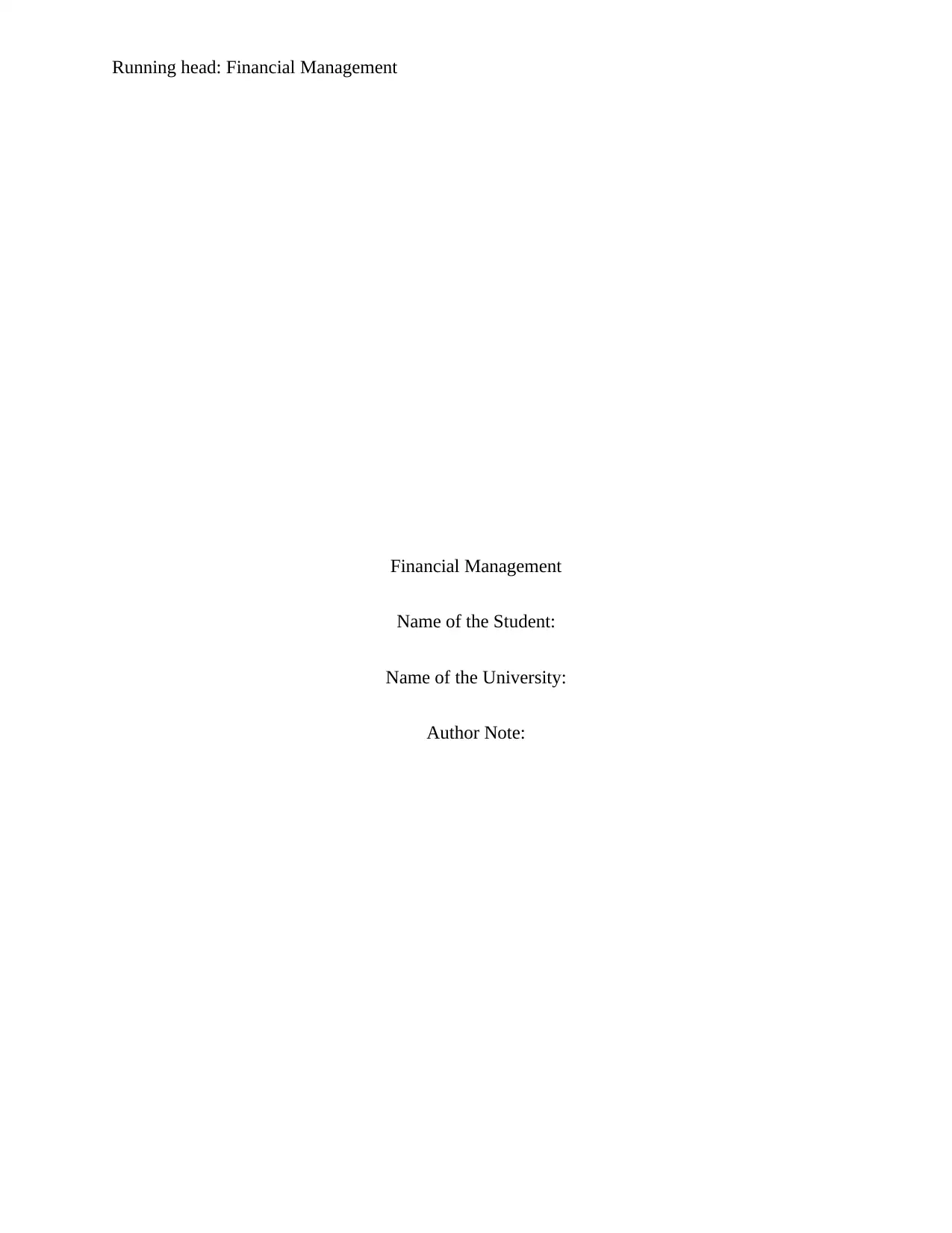
Running head: Financial Management
Financial Management
Name of the Student:
Name of the University:
Author Note:
Financial Management
Name of the Student:
Name of the University:
Author Note:
Paraphrase This Document
Need a fresh take? Get an instant paraphrase of this document with our AI Paraphraser
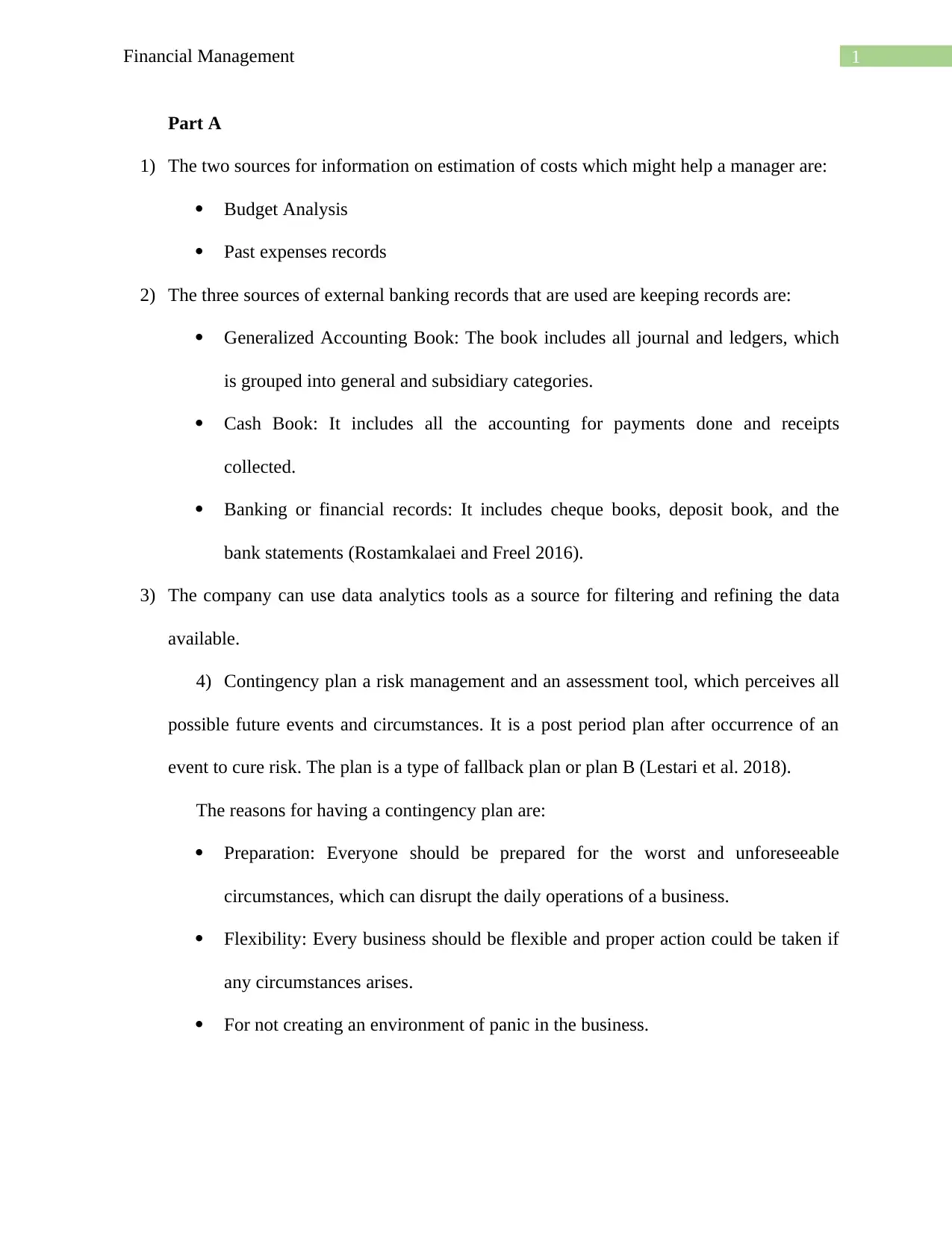
1Financial Management
Part A
1) The two sources for information on estimation of costs which might help a manager are:
Budget Analysis
Past expenses records
2) The three sources of external banking records that are used are keeping records are:
Generalized Accounting Book: The book includes all journal and ledgers, which
is grouped into general and subsidiary categories.
Cash Book: It includes all the accounting for payments done and receipts
collected.
Banking or financial records: It includes cheque books, deposit book, and the
bank statements (Rostamkalaei and Freel 2016).
3) The company can use data analytics tools as a source for filtering and refining the data
available.
4) Contingency plan a risk management and an assessment tool, which perceives all
possible future events and circumstances. It is a post period plan after occurrence of an
event to cure risk. The plan is a type of fallback plan or plan B (Lestari et al. 2018).
The reasons for having a contingency plan are:
Preparation: Everyone should be prepared for the worst and unforeseeable
circumstances, which can disrupt the daily operations of a business.
Flexibility: Every business should be flexible and proper action could be taken if
any circumstances arises.
For not creating an environment of panic in the business.
Part A
1) The two sources for information on estimation of costs which might help a manager are:
Budget Analysis
Past expenses records
2) The three sources of external banking records that are used are keeping records are:
Generalized Accounting Book: The book includes all journal and ledgers, which
is grouped into general and subsidiary categories.
Cash Book: It includes all the accounting for payments done and receipts
collected.
Banking or financial records: It includes cheque books, deposit book, and the
bank statements (Rostamkalaei and Freel 2016).
3) The company can use data analytics tools as a source for filtering and refining the data
available.
4) Contingency plan a risk management and an assessment tool, which perceives all
possible future events and circumstances. It is a post period plan after occurrence of an
event to cure risk. The plan is a type of fallback plan or plan B (Lestari et al. 2018).
The reasons for having a contingency plan are:
Preparation: Everyone should be prepared for the worst and unforeseeable
circumstances, which can disrupt the daily operations of a business.
Flexibility: Every business should be flexible and proper action could be taken if
any circumstances arises.
For not creating an environment of panic in the business.
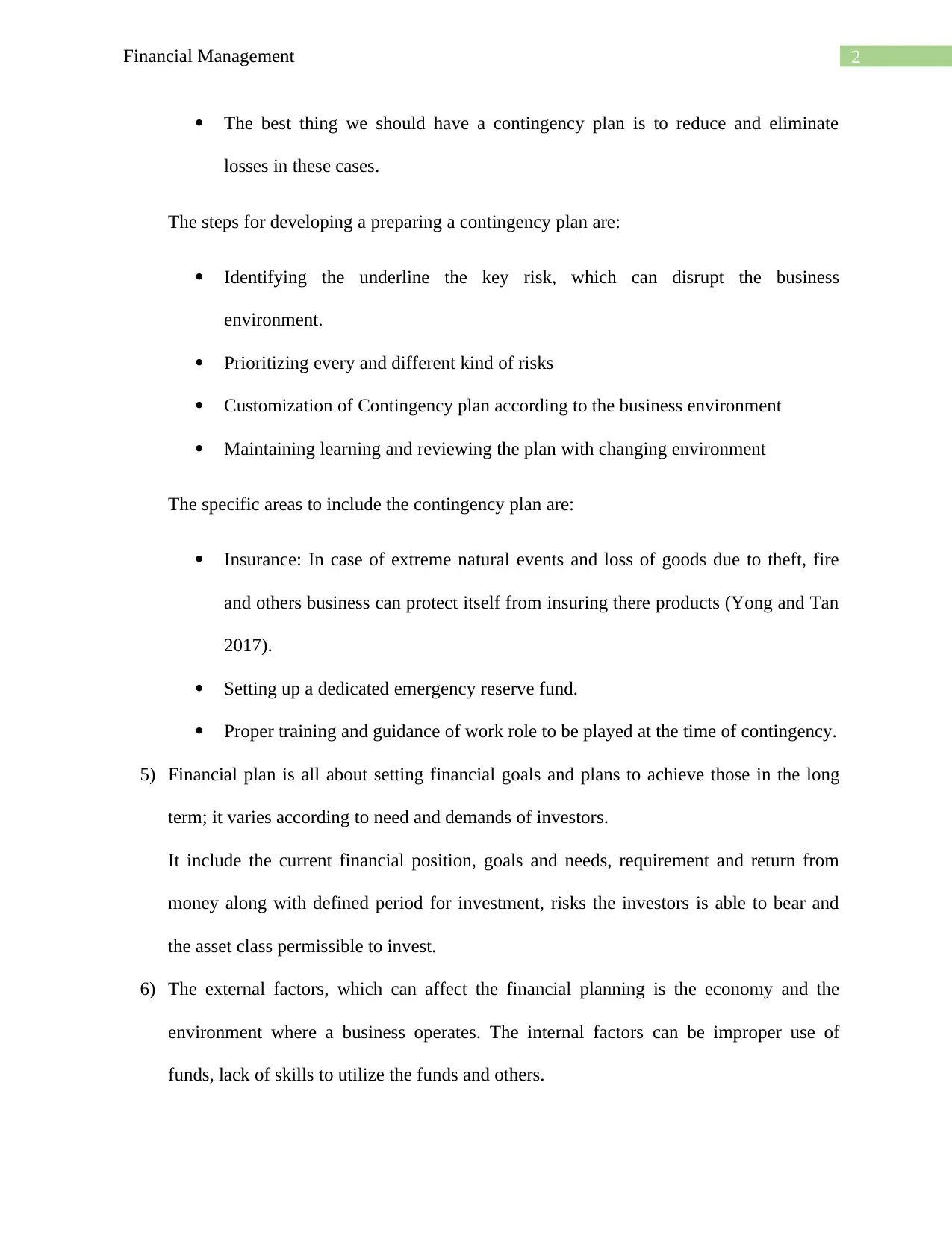
2Financial Management
The best thing we should have a contingency plan is to reduce and eliminate
losses in these cases.
The steps for developing a preparing a contingency plan are:
Identifying the underline the key risk, which can disrupt the business
environment.
Prioritizing every and different kind of risks
Customization of Contingency plan according to the business environment
Maintaining learning and reviewing the plan with changing environment
The specific areas to include the contingency plan are:
Insurance: In case of extreme natural events and loss of goods due to theft, fire
and others business can protect itself from insuring there products (Yong and Tan
2017).
Setting up a dedicated emergency reserve fund.
Proper training and guidance of work role to be played at the time of contingency.
5) Financial plan is all about setting financial goals and plans to achieve those in the long
term; it varies according to need and demands of investors.
It include the current financial position, goals and needs, requirement and return from
money along with defined period for investment, risks the investors is able to bear and
the asset class permissible to invest.
6) The external factors, which can affect the financial planning is the economy and the
environment where a business operates. The internal factors can be improper use of
funds, lack of skills to utilize the funds and others.
The best thing we should have a contingency plan is to reduce and eliminate
losses in these cases.
The steps for developing a preparing a contingency plan are:
Identifying the underline the key risk, which can disrupt the business
environment.
Prioritizing every and different kind of risks
Customization of Contingency plan according to the business environment
Maintaining learning and reviewing the plan with changing environment
The specific areas to include the contingency plan are:
Insurance: In case of extreme natural events and loss of goods due to theft, fire
and others business can protect itself from insuring there products (Yong and Tan
2017).
Setting up a dedicated emergency reserve fund.
Proper training and guidance of work role to be played at the time of contingency.
5) Financial plan is all about setting financial goals and plans to achieve those in the long
term; it varies according to need and demands of investors.
It include the current financial position, goals and needs, requirement and return from
money along with defined period for investment, risks the investors is able to bear and
the asset class permissible to invest.
6) The external factors, which can affect the financial planning is the economy and the
environment where a business operates. The internal factors can be improper use of
funds, lack of skills to utilize the funds and others.
⊘ This is a preview!⊘
Do you want full access?
Subscribe today to unlock all pages.

Trusted by 1+ million students worldwide
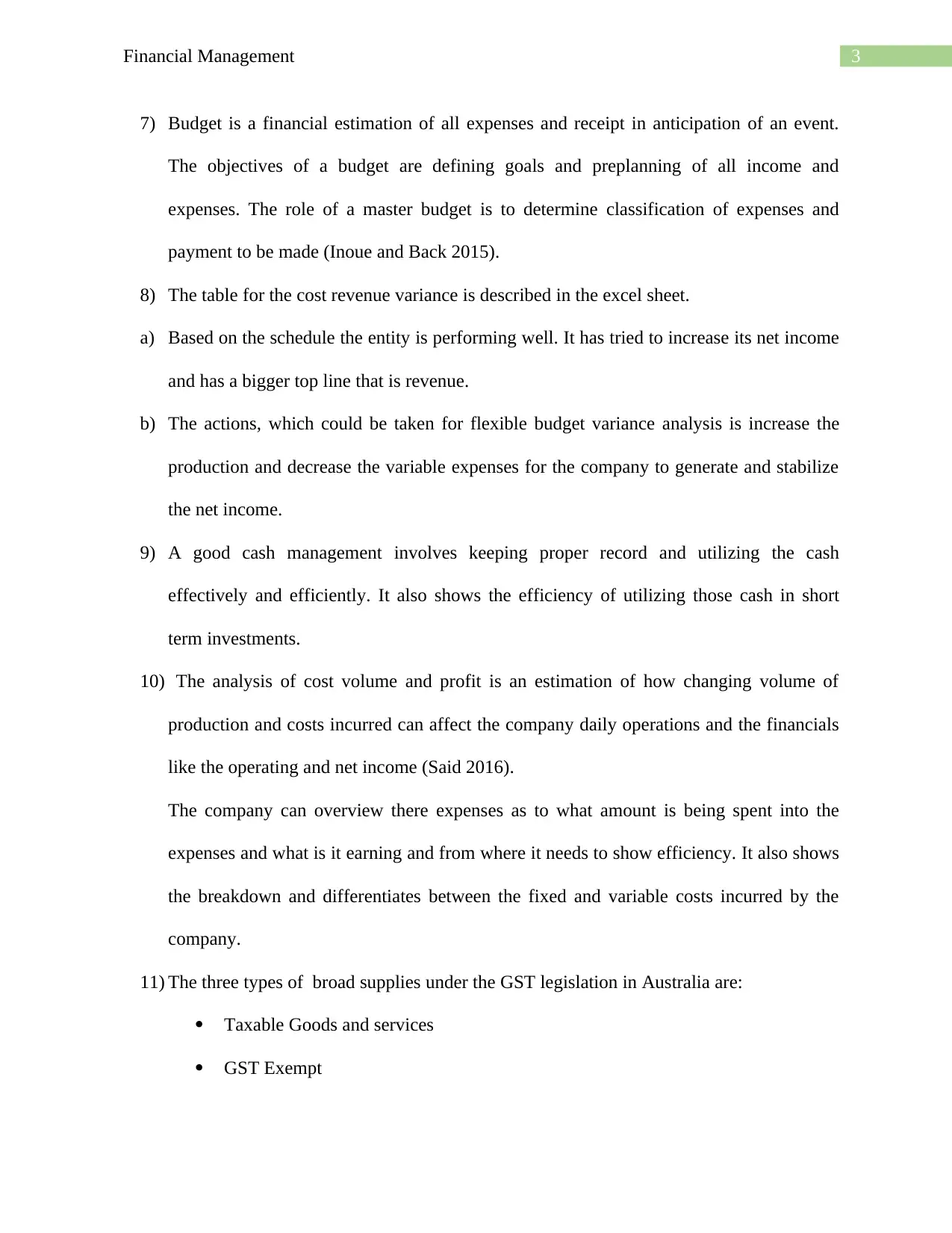
3Financial Management
7) Budget is a financial estimation of all expenses and receipt in anticipation of an event.
The objectives of a budget are defining goals and preplanning of all income and
expenses. The role of a master budget is to determine classification of expenses and
payment to be made (Inoue and Back 2015).
8) The table for the cost revenue variance is described in the excel sheet.
a) Based on the schedule the entity is performing well. It has tried to increase its net income
and has a bigger top line that is revenue.
b) The actions, which could be taken for flexible budget variance analysis is increase the
production and decrease the variable expenses for the company to generate and stabilize
the net income.
9) A good cash management involves keeping proper record and utilizing the cash
effectively and efficiently. It also shows the efficiency of utilizing those cash in short
term investments.
10) The analysis of cost volume and profit is an estimation of how changing volume of
production and costs incurred can affect the company daily operations and the financials
like the operating and net income (Said 2016).
The company can overview there expenses as to what amount is being spent into the
expenses and what is it earning and from where it needs to show efficiency. It also shows
the breakdown and differentiates between the fixed and variable costs incurred by the
company.
11) The three types of broad supplies under the GST legislation in Australia are:
Taxable Goods and services
GST Exempt
7) Budget is a financial estimation of all expenses and receipt in anticipation of an event.
The objectives of a budget are defining goals and preplanning of all income and
expenses. The role of a master budget is to determine classification of expenses and
payment to be made (Inoue and Back 2015).
8) The table for the cost revenue variance is described in the excel sheet.
a) Based on the schedule the entity is performing well. It has tried to increase its net income
and has a bigger top line that is revenue.
b) The actions, which could be taken for flexible budget variance analysis is increase the
production and decrease the variable expenses for the company to generate and stabilize
the net income.
9) A good cash management involves keeping proper record and utilizing the cash
effectively and efficiently. It also shows the efficiency of utilizing those cash in short
term investments.
10) The analysis of cost volume and profit is an estimation of how changing volume of
production and costs incurred can affect the company daily operations and the financials
like the operating and net income (Said 2016).
The company can overview there expenses as to what amount is being spent into the
expenses and what is it earning and from where it needs to show efficiency. It also shows
the breakdown and differentiates between the fixed and variable costs incurred by the
company.
11) The three types of broad supplies under the GST legislation in Australia are:
Taxable Goods and services
GST Exempt
Paraphrase This Document
Need a fresh take? Get an instant paraphrase of this document with our AI Paraphraser
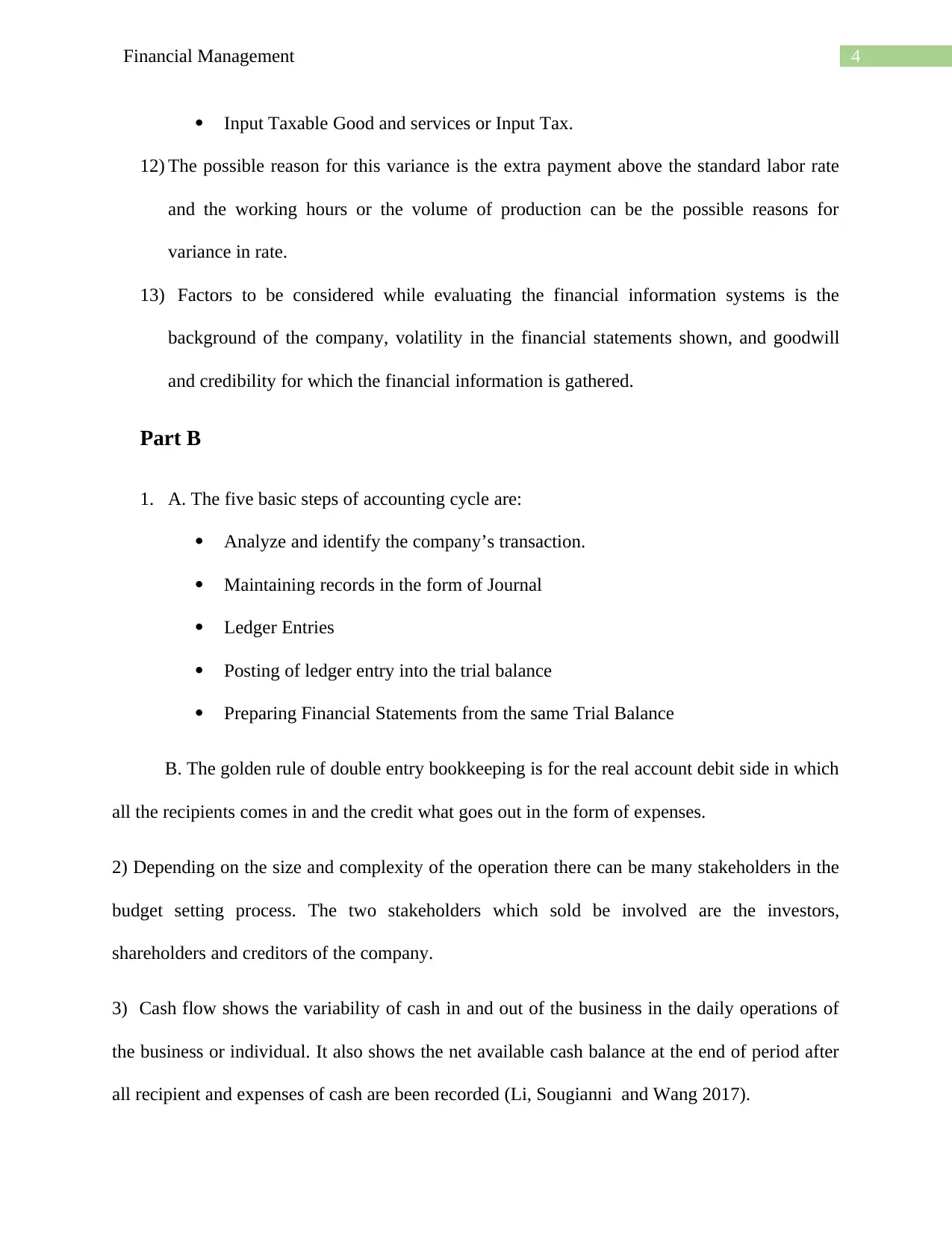
4Financial Management
Input Taxable Good and services or Input Tax.
12) The possible reason for this variance is the extra payment above the standard labor rate
and the working hours or the volume of production can be the possible reasons for
variance in rate.
13) Factors to be considered while evaluating the financial information systems is the
background of the company, volatility in the financial statements shown, and goodwill
and credibility for which the financial information is gathered.
Part B
1. A. The five basic steps of accounting cycle are:
Analyze and identify the company’s transaction.
Maintaining records in the form of Journal
Ledger Entries
Posting of ledger entry into the trial balance
Preparing Financial Statements from the same Trial Balance
B. The golden rule of double entry bookkeeping is for the real account debit side in which
all the recipients comes in and the credit what goes out in the form of expenses.
2) Depending on the size and complexity of the operation there can be many stakeholders in the
budget setting process. The two stakeholders which sold be involved are the investors,
shareholders and creditors of the company.
3) Cash flow shows the variability of cash in and out of the business in the daily operations of
the business or individual. It also shows the net available cash balance at the end of period after
all recipient and expenses of cash are been recorded (Li, Sougianni and Wang 2017).
Input Taxable Good and services or Input Tax.
12) The possible reason for this variance is the extra payment above the standard labor rate
and the working hours or the volume of production can be the possible reasons for
variance in rate.
13) Factors to be considered while evaluating the financial information systems is the
background of the company, volatility in the financial statements shown, and goodwill
and credibility for which the financial information is gathered.
Part B
1. A. The five basic steps of accounting cycle are:
Analyze and identify the company’s transaction.
Maintaining records in the form of Journal
Ledger Entries
Posting of ledger entry into the trial balance
Preparing Financial Statements from the same Trial Balance
B. The golden rule of double entry bookkeeping is for the real account debit side in which
all the recipients comes in and the credit what goes out in the form of expenses.
2) Depending on the size and complexity of the operation there can be many stakeholders in the
budget setting process. The two stakeholders which sold be involved are the investors,
shareholders and creditors of the company.
3) Cash flow shows the variability of cash in and out of the business in the daily operations of
the business or individual. It also shows the net available cash balance at the end of period after
all recipient and expenses of cash are been recorded (Li, Sougianni and Wang 2017).
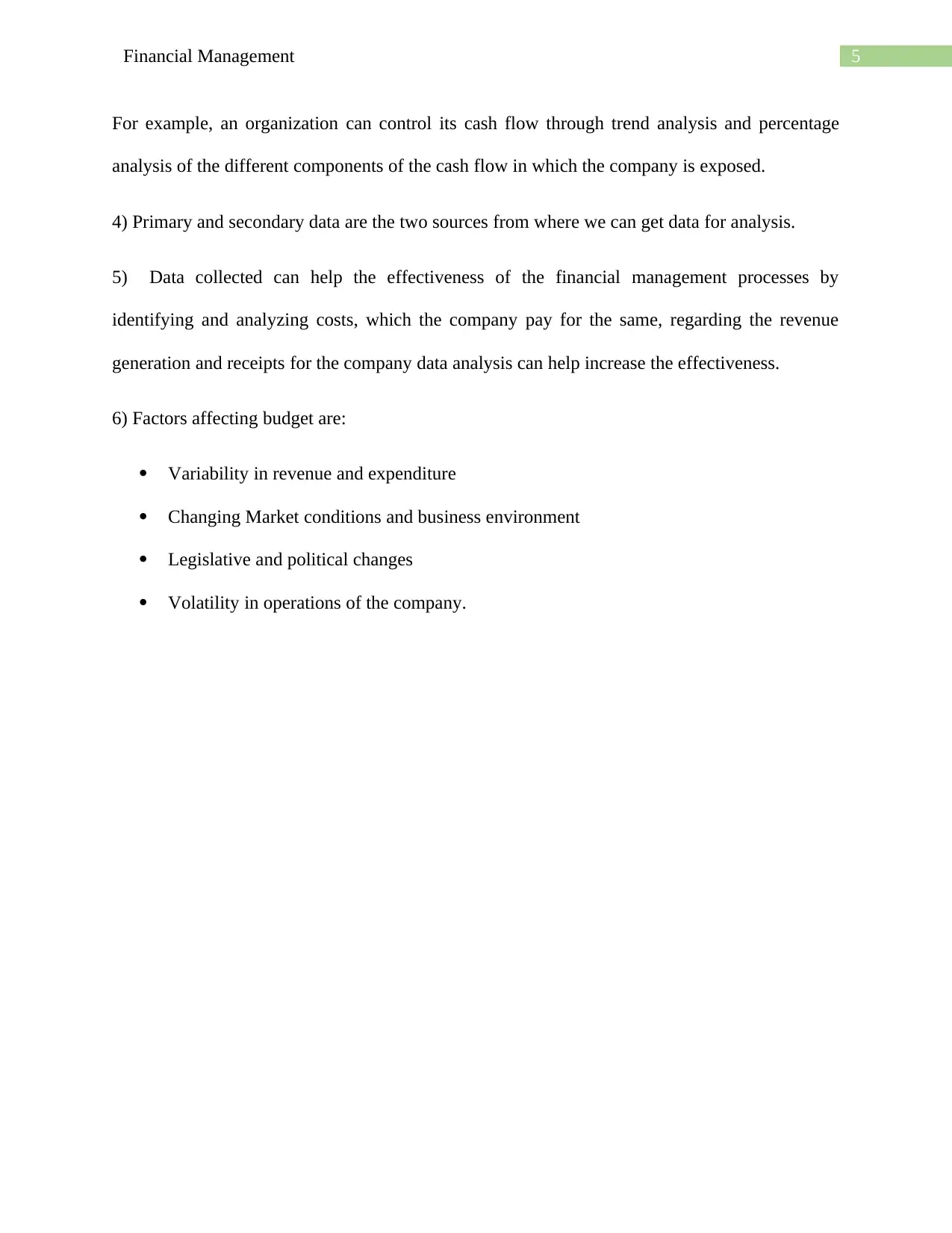
5Financial Management
For example, an organization can control its cash flow through trend analysis and percentage
analysis of the different components of the cash flow in which the company is exposed.
4) Primary and secondary data are the two sources from where we can get data for analysis.
5) Data collected can help the effectiveness of the financial management processes by
identifying and analyzing costs, which the company pay for the same, regarding the revenue
generation and receipts for the company data analysis can help increase the effectiveness.
6) Factors affecting budget are:
Variability in revenue and expenditure
Changing Market conditions and business environment
Legislative and political changes
Volatility in operations of the company.
For example, an organization can control its cash flow through trend analysis and percentage
analysis of the different components of the cash flow in which the company is exposed.
4) Primary and secondary data are the two sources from where we can get data for analysis.
5) Data collected can help the effectiveness of the financial management processes by
identifying and analyzing costs, which the company pay for the same, regarding the revenue
generation and receipts for the company data analysis can help increase the effectiveness.
6) Factors affecting budget are:
Variability in revenue and expenditure
Changing Market conditions and business environment
Legislative and political changes
Volatility in operations of the company.
⊘ This is a preview!⊘
Do you want full access?
Subscribe today to unlock all pages.

Trusted by 1+ million students worldwide
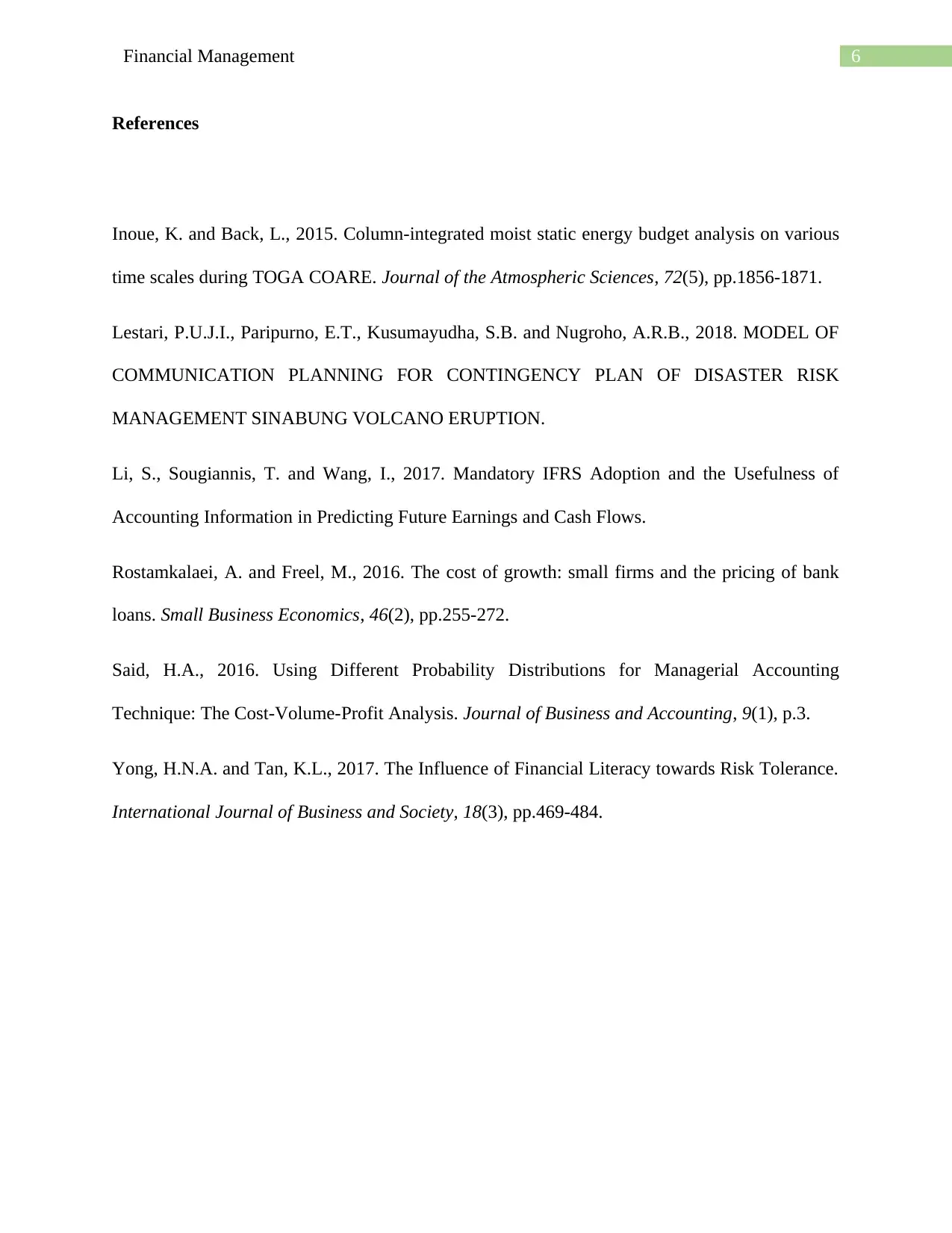
6Financial Management
References
Inoue, K. and Back, L., 2015. Column-integrated moist static energy budget analysis on various
time scales during TOGA COARE. Journal of the Atmospheric Sciences, 72(5), pp.1856-1871.
Lestari, P.U.J.I., Paripurno, E.T., Kusumayudha, S.B. and Nugroho, A.R.B., 2018. MODEL OF
COMMUNICATION PLANNING FOR CONTINGENCY PLAN OF DISASTER RISK
MANAGEMENT SINABUNG VOLCANO ERUPTION.
Li, S., Sougiannis, T. and Wang, I., 2017. Mandatory IFRS Adoption and the Usefulness of
Accounting Information in Predicting Future Earnings and Cash Flows.
Rostamkalaei, A. and Freel, M., 2016. The cost of growth: small firms and the pricing of bank
loans. Small Business Economics, 46(2), pp.255-272.
Said, H.A., 2016. Using Different Probability Distributions for Managerial Accounting
Technique: The Cost-Volume-Profit Analysis. Journal of Business and Accounting, 9(1), p.3.
Yong, H.N.A. and Tan, K.L., 2017. The Influence of Financial Literacy towards Risk Tolerance.
International Journal of Business and Society, 18(3), pp.469-484.
References
Inoue, K. and Back, L., 2015. Column-integrated moist static energy budget analysis on various
time scales during TOGA COARE. Journal of the Atmospheric Sciences, 72(5), pp.1856-1871.
Lestari, P.U.J.I., Paripurno, E.T., Kusumayudha, S.B. and Nugroho, A.R.B., 2018. MODEL OF
COMMUNICATION PLANNING FOR CONTINGENCY PLAN OF DISASTER RISK
MANAGEMENT SINABUNG VOLCANO ERUPTION.
Li, S., Sougiannis, T. and Wang, I., 2017. Mandatory IFRS Adoption and the Usefulness of
Accounting Information in Predicting Future Earnings and Cash Flows.
Rostamkalaei, A. and Freel, M., 2016. The cost of growth: small firms and the pricing of bank
loans. Small Business Economics, 46(2), pp.255-272.
Said, H.A., 2016. Using Different Probability Distributions for Managerial Accounting
Technique: The Cost-Volume-Profit Analysis. Journal of Business and Accounting, 9(1), p.3.
Yong, H.N.A. and Tan, K.L., 2017. The Influence of Financial Literacy towards Risk Tolerance.
International Journal of Business and Society, 18(3), pp.469-484.
1 out of 7
Related Documents
Your All-in-One AI-Powered Toolkit for Academic Success.
+13062052269
info@desklib.com
Available 24*7 on WhatsApp / Email
![[object Object]](/_next/static/media/star-bottom.7253800d.svg)
Unlock your academic potential
Copyright © 2020–2025 A2Z Services. All Rights Reserved. Developed and managed by ZUCOL.





